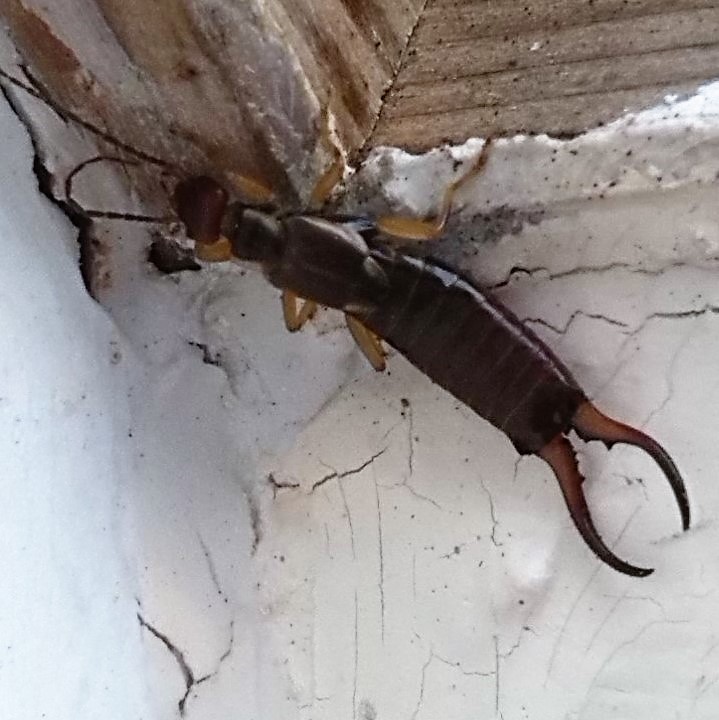The scourge of the Forkie Tailies have always been a terror to behold, despite the lack of any danger at all, these beasties are sure to give any Dundonian the heebie jeebies when we spot one.
Commonly referred to as earwigs, and notoriously feared for the false rumour that they will burrow into people’s ears and lay their eggs, the fear of these pests was further escalated in Japan, where they are known as ‘penis cutters’.
However, textbooks of entomology will have us know that these insects are nocturnal and that, as they are not social animals, they usually don’t form colonies or congregate in large numbers. That was, however, until a Dundee Courier reporter brought attention to the seemingly rebellious Forkie Tailies of 1929, who came out of their usual homes outside and invaded the steel houses of Craigiebank (around Craigie Avenue and Greendykes Road) with a fury.

Unfortunately, we didn’t have time to include this story in our Riddled tour, but I did get the feeks just reading about the invasion of millions of forkie tailies, and now you can too. Also watch out for the wonderful wit of the reporter who wrote gems such as “The forkies simply flapped their anal forceps at him”.
In any case, it’s safe to say the residents of Craigiebank were far from delighted about their uninvited guests that summer.
————————————————————
Dundee Courier – Thursday 05 September 1929
PLAGUE OF EARWIGS IN DUNDEE
STEEL-HOUSE COLONY INVASION
Tenants’ War on “Forkie”
A plague of earwigs is causing something like a reign of terror in part of the steel house colony at Craigiebank, Dundee. It seems as if all the world’s earwigs have concentrated in these few blocks of steel houses.
The earwig, or, as the Dundonian calls it, the forkie tailie, or forkie for short, is not noted for its discrimination, but for some mysterious reason the insects have confined their attentions to the steel houses and have ignored those dwellings nearby that are composed of brick and mortar.
It is a fact that the steel houses were recently painted in delicate tints of pink and brown and yellow, and the forkie may possess hitherto unsuspected aesthetic tastes.
Be that as it may. The forkie to the number of several millions has taken possession of these steel houses. Hamelin with its rats has nothing on the steel houses. True, forkies are of a uniform size and colour, and, unlike the Hamelin visitation, there are no big forkies and small forkies and black forkies and gray forkies. They are merely forkies.
But no Pied Piper has appeared at Craigiebank.
The occupants of the steel houses have gardens, and so expect to see a forkie or two lurking among the foliage of their dahlias, for which flower the forkie has a well-known predilection. A forkie individually is by no means a fearsome insect, but the forkie in the mass, and in the house at that, is a different proposition.
Do Not Hide By Day.
Normally, as any encyclopaedia will tell you, the earwig is an insect of the cockroach family, is of nocturnal habits, lives on vegetable matter, and hides by day under stones or bark.
The Craigiebank forkies have let the encyclopaedias down. They do not hide by day. They crawl all over the walls inside the houses, all over the roofs, on the floors, on the tables; in fact, the houses are a moving mass of forkies. They are everywhere.
The good man of the house may be enjoying his cup of tea, when a forkie misses his step on the ceiling and plumps into the tea.
When bedtime comes and the beds have to be shaken out to clear away the invaders. Campaigns of slaughter are futile. Kill them by the hundred and the forkies advance in serried ranks. Their reserves are inexhaustible.
The harassed tenants, unable to cope with the pests, appealed to the factor. Forkies, however, are not amenable to ejectment notices, and the factor was impotent. The forkies simply flapped their anal forceps at him.
It was felt that expert knowledge was required to deal with such an extraordinary problem, and the assistance of a professor from University College was enlisted, one versed in the science of zoology and therefore wise in the ways of the aggressive forkie. He duly visited the afflicted area, and suggested remedies such as the spraying of the house with a weak solution of disinfectant.
Nothing to be Alarmed About
The professor was not very willing to discuss the matter. He agreed that from a scientific point of view it was very interesting, which was not very consoling to the invaded householders. He did not think there was anything to be alarmed at and that the invasion would be of short duration. He had examined the ground, and it was no more conducive to the breeding of the forkie than any other part of the city.
Possibly the Craigiebank forkie clan had found a breeding ground to their liking and had flourished like the green bay tree. Only the forkie knows, and he won’t tell.
The experts believe that it is only a passing phase and that the forkies will soon fade away and join the great company of flies in that mysterious region to which they retire in the winter time.
Meanwhile there is a strong smell of disinfectant around Craigiebank that has vanquished even the odour from the gas works – which, after all, is something to be thankful for.
– DD Tours operates walking tours in Dundee city, covering dark local history such as wars, battles, murders, diseases, riots, disasters and executions. Walk with us for an unforgettable storytelling experience.
OR
